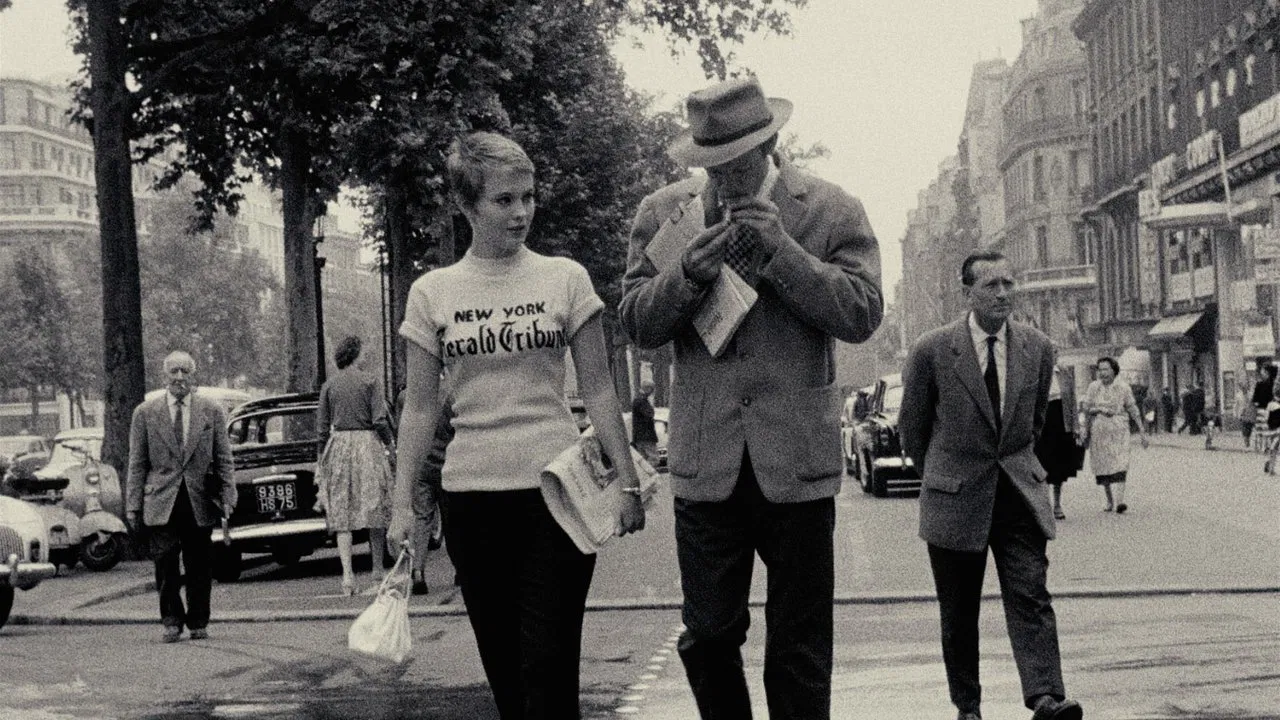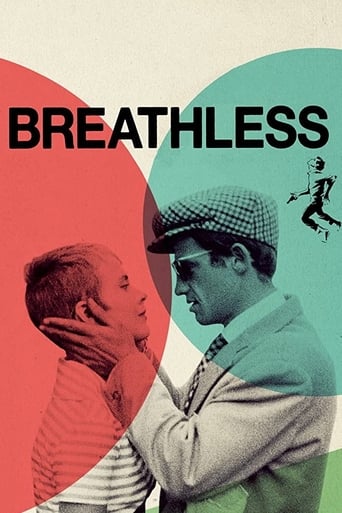

You won't be disappointed!
... View MoreBrilliant and touching
... View MoreThis story has more twists and turns than a second-rate soap opera.
... View MoreGreat example of an old-fashioned, pure-at-heart escapist event movie that doesn't pretend to be anything that it's not and has boat loads of fun being its own ludicrous self.
... View MoreHailed among the films that started the French New Wave, Jean-Luc Godard's "Breathless" is a choppy, anarchic film as commanding as it is carefree. A riff on the American crime/gangster films of the two decades that preceded it, "Breathless" has aspects of both imitation and transcendence, but mostly a liberated spirit that no doubt constituted a change in French filmmaking.Embodying that spirit is star Jean-Paul Belmondo as car thief Michel Poiccard, a man who lives by the whim of his desire, even when it means grinding his ever-thrumming internal engine to a halt for the sake of a woman, specifically Patricia (Jean Seberg), an American in Paris hawking newspapers as she aspires to be a journalist. Although Belmondo's performance sets the tone and guides the film (as does Michel's shooting of a police officer, inciting the action), in so many ways it revolves around Seberg's driven, liberated feminine energy.Godard's use of jump cuts (a film technique born out of a need to cut down the runtime while avoiding chopping entire scenes) suggests he's something of a rebel filmmaker, but there are lengthy takes too as time seems to stop in Patricia's apartment as they each feel out how they feel about each other. Michel's relentless libido seems to dominate this section in a rather distracting way, but operating in minimal space, Godard shows his sure-handedness and awareness of the classic cinematic techniques that surely inspired him.With the exception of when Belmondo and Seberg share screen time, the storytelling isn't nearly as compelling as the energy and style of the film. The way that the romance and the crime story cross paths in the end turns out to be a saving grace of the narrative and make a good case for the film as an intellectual accomplishment, but if the film is indeed a triumph, it's because of the visuals, the pacing, the repetition of the jazz piano score culminating in a wholly unique cinematic experience.Above all else, "Breathless" embodies this feverish, burning passion of cinema as art form, evident purely in its playfulness and recklessness. It stands today as a window into a laboratory of new filmmaking ideas; Godard tried to balance the classic mise en scene with a new approach to stitching scenes together, all while staying relevant to the culture and philosophy of its era. Perhaps this is how all great cinematic turning points are made; a true cinefile in his or her day borrows from his or her inspiration while striving to tell a familiar story in a way that may push boundaries, but will certainly speak more to emerging tastes and attitudes.Without historical context, "Breathless" is no masterpiece identified as powerfully influential, but in this case, context is nearly everything.
... View MoreI was filled with anxiety before beginning Breathless. As someone who is firmly entrenched in the Truffaut camp, #TruffautisLife after all, I was terrified that I would see what is often regarded as the director with whom Truffaut shared an open and intense parting of ways with and see the masterpiece I've always been told it was. Obviously, I know that appreciating a Godard film will do nothing to diminish my love for all things Truffaut, I'm just a loyalist and was worried how I'd feel enjoying a Godard film. Little did I know, I had nothing to worry about. I actively disliked Breathless, I may have even hated it. Jean-Luc Godard's 1960 film was important, I suppose, to the burgeoning French New Wave. I'm sure to subject myself to more Godard films in the future as my journey through cinema goes on, but Breathless did not live up to its reputation, for me.This is where the plot would go if there was one. Just kidding, sort of, there are happenings in Breathless but it is clear that there were not many rehearsals with a script taking place. I've read that Godard was rewriting the script each day, removing nearly all of the influence of Truffaut, who had given the film's story to Godard. Godard would then feed the lines to the actors from offset resulting in very little familiarity between the words of the script and the actors speaking them. Michel Poiccard (Jean-Paul Belmondo) a self-absorbed narcissistic sociopath, surely modeled after Jean-Luc Godard, steals a car then murders the police officer who chases after him. Needing a distraction and a place to hide out, Michel renews his relationship with Patricia Franchini (Jean Seberg) an American in Paris studying journalism whom he met a few weeks prior. Despite their relationship being new and unestablished, Michel expects Patricia to accompany him on his getaway to Italy. Like a true narcissist, Michel is oblivious to the fact that his face is in all the papers and the police are closing in on him as he goes about his way collecting his money and planning his getaway. Focusing his attention on the American films that interest him and his American love interest, Michel ignores the fact that his very life is at stake.During the opening minutes of the film, Jean-Paul Belmondo breaks the fourth wall by looking at and speaking directly to the camera which is a device that almost always works for me. I thought that meant that I may be in for something good, but almost immediately after this scene ended, I nearly ran out of things to enjoy. The jump cuts were amazing and served the story well. I don't give Godard credit for inventing those cuts, as many do, however. An idol, Sergei Eisenstein used jump cuts in film--most memorably in depicting an explosion in The Battleship Potemkin. Georges Melies, whose work I have memorialized on my body also used jump cuts through most of his career in silent cinema. Despite the fact that Godard often gets credit for inventing the jump cut which he surely did not, I can't argue the fact that he used the technique effectively cementing certain aspects of The French New Wave. The music was phenomenal, so kudos to Godard for that. From his first film, however, one can see my biggest criticism of Godard. Godard has no problem excluding his audience. Just listening to Godard speak in interviews, it's clear to discern that he only expects the highest brow of intellectuals to enjoy his films. If an audience member doesn't fit into that category, he doesn't really care. He created terribly unlikeable characters engaging in a plot and a romance that no one could possibly care about, all the while carrying on pseudo-intellectual conversations grating on the last bit of patience I could muster. Obviously, Breathless works for almost everyone except me, but after seeing his debut feature, there's not much encouraging me to try more Godard films.
... View MoreBesides the fact that you will save $100,000 another reason to skip Film School is that you won't be required to sit through a screening of "Breathless" - a class that should be titled "How to Make a Self-Indulgent Home Movie Posing As Art" that examines what is essentially an exercise in cinematic masturbation.Okay, Godard did things differently. He not only ignored The Rules of filmmaking; he thumbed his nose at them. This may be enough to endear him to immature film students because of the rebellious nature of youth. This sentiment is usually reinforced when they learn that he is a life-long Communist, which is like, so cool! (No traditional bourgeois filmmaking principles like "Telling a Story" for Godard. How liberating!) Unfortunately, it is also the folly of youth to believe that New & Different is somehow synonymous with Innovative & Better - a notion has clouded the judgement of many seemingly rational people old enough to know better when it comes to their assessment of what constitutes Art. Watching early works of Godard like "À Bout de Soufflé" and "Pierrot le Fou" reminds me of a child exclaiming, Mommy, Daddy - look at me! Look at what I'm doing." Nonetheless there are actually two good reasons why you should bite the bullet (or take a stiff drink) and watch "Breathless." The first is the very 50s-ish jazzy score by Martial Solal, which totally fits the film and captures the atmosphere in the disjointed and somewhat crazy scenario (such as it is.) The second reason is the incomparable Jean Seberg. You will become captivated by her as soon as she appears on the screen, but then you will fall hopelessly in love with this utterly charming gamin Américaine when you see her slowly walking on the Champs-Elysees calling out, "New York Herald Tribune" with newspapers that she is trying to sell bundled in her arm.Godard famously said, "All that you need to make a good film is a girl and a gun." At least he was half right.
... View More"Modern movies begin here," said Roger Ebert about Breathless, one of the most influential films of all time. Breathless exploded film into the modern age with its radical use of jump-cut editing, a jazzy score, and its overall sensation of freedom. One of the early films of the French New Wave, it has a powerful sense of youth and was a conscious break from the traditional, more conservative method of film-making. It shattered the mold, broke all the rules, and became an inspiration to new film-makers for decades to come. The story is relatively simple, about a murder suspect, Michel, evading the law in Paris, seemingly without a care in the world, while hanging out with his American girlfriend, Patricia, who establishes herself as an interesting and powerful character in her own right. Michel seems more interested in getting laid than getting away, and at times is resigned to spending his life in jail. But in the end he wouldn't go quietly, free until his last breath. The film has a constantly moving camera, which leaves the audience breathless as well, and cinema was forever changed.
... View More